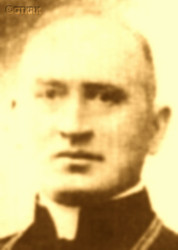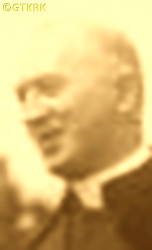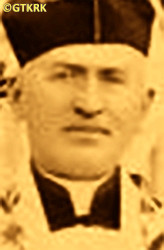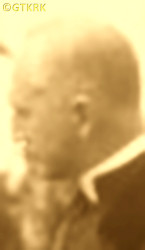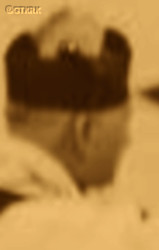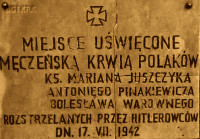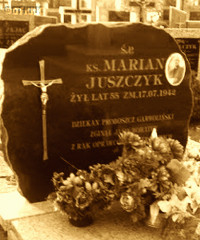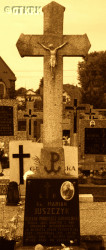Roman Catholic
St Sigismund parish
05-507 Słomczyn
85 Wiślana Str.
Konstancin deanery
Warsaw archdiocese, Poland
full list:
displayClick to display full list

searchClick to search full list by categories
wyświetlKliknij by wyświetlić pełną listę po polsku

szukajKliknij by przeszukać listę wg kategorii po polsku

Martyrology of the clergy — Poland
XX century (1914 – 1989)
personal data
surname
JUSZCZYK
forename(s)
Marian Dominic (pl. Marian Dominik)
function
diocesan priest
creed
Latin (Roman Catholic) Church RCmore on
en.wikipedia.org
[access: 2014.09.21]
diocese / province
Siedlce diocesemore on
en.wikipedia.org
[access: 2022.01.06]
Janów Podlaski diocesemore on
www.catholic-hierarchy.org
[access: 2021.12.19]
Lublin diocesemore on
pl.wikipedia.org
[access: 2013.05.19]
RC Military Ordinariate of Polandmore on
en.wikipedia.org
[access: 2014.12.20]
honorary titles
honorary canonmore on
honorary canon
(Holy Trinity RC collegiate church, Janów Podlaskitoday: Janów Podlaski gm., Biała Podlaska pov., Lublin voiv., Poland
more on
en.wikipedia.org
[access: 2021.12.18])
date and place
of death
17.07.1942

Pilawatoday: Pilawa gm., Garwolin pov., Masovia voiv., Poland
more on
en.wikipedia.org
[access: 2022.01.28]
details of death
During the Polish–Russian war of 1919‐1921, when the invading Russian troops were approaching central Poland in 08.1920, warned by the Orthodox population, left the territory of his Dolhobrody parish.
After the Russian defeat in the Battle of Warsaw around c. 15.08.1920 (known as the „Miracle on the Vistula river”), returned.
Similarly, after German and Russian invasion of Poland in 09.1939 and start of World War II, left his Garwolin parish with thousands of refugees.
After start of German occupation returned.
On 10.05.1940 evicted by the Germans from his rectory.
Found refuge in one of his parishioners' houses in Rębków and from there every day marched c. 5 km to and back from Garwolin.
Chaplain of the clandestine resistance Armed Struggle Union ZWZ, and then the Home Army AK (part of the Polish Clandestine State) — its branch in Garwolin, formed by former soldiers before of the 1st Regiment of Mounted Riflemen of the Polish Army, before the German aggression stationed in Garwolin.
Arrested by the Germans on 17.07.1942.
Taken to Garwolingaol.
On the same day taken to a forest by the Pilawa–Łucznica road and murdered with two of his parishioners.
Despite warnings from the Home Army AK about a possible arrest, did not leave the parish and did not hide.
Arrested by the Germans on 17.07.1942, together with a prominent member of the AK „Gołąb” — Garwolin region, Ensign Witczak–Witaczyński, nom‐de‐guerre „Kościesza” and two parishioners.
Taken to the arrest in Garwolin and driven out the city the same day, then murdered on the Pilawa–Łucznica road (c. 10 km from Garwolin), in the nearby forest, together with the aforementioned two parishioners.
Ensign Witczaki–Witaczyński was murdered by the Germans in the German KL Lublin concentration camp.
cause of death
mass murder
perpetrators
Germans
sites and events
GeneralgouvernementClick to display the description, Ribbentrop‐MolotovClick to display the description, Pius XI's encyclicalsClick to display the description, Polish‐Russian war of 1919‐1921Click to display the description
date and place
of birth
03.08.1887

Łapiszatoday: district of Będzin, Będzin urban gm., Będzin pov., Silesia voiv., Poland
more on
en.wikipedia.org
[access: 2020.12.11]
alt. dates and places
of birth
03.07.1887, 04.08.1887
presbyter (holy orders)
ordination
14.07.1913

positions held
1929 – 1942
parish priest — Garwolintoday: Garwolin gm., Garwolin pov., Masovia voiv., Poland
more on
en.wikipedia.org
[access: 2021.09.29] ⋄ Transfiguration of the Lord RC parish ⋄ Garwolintoday: Garwolin gm., Garwolin pov., Masovia voiv., Poland
more on
en.wikipedia.org
[access: 2021.09.29] RC deanery
1927 – 1941
dean — Garwolintoday: Garwolin gm., Garwolin pov., Masovia voiv., Poland
more on
en.wikipedia.org
[access: 2021.09.29] RC deanery
1930 – 1939
RC auxiliary military chaplain — Garwolintoday: Garwolin gm., Garwolin pov., Masovia voiv., Poland
more on
en.wikipedia.org
[access: 2021.09.29] ⋄ garrison, Corps District OK No. II Lublin, Polish Armed Forces — also: chaplain of the 1st Mounted Rifle Regiment
1929 – 1934
membership — Garwolintoday: Garwolin gm., Garwolin pov., Masovia voiv., Poland
more on
en.wikipedia.org
[access: 2021.09.29] ⋄ City Council — also: of the district council
1929
parish priest — Górznotoday: Górzno gm., Garwolin pov., Masovia voiv., Poland
more on
en.wikipedia.org
[access: 2021.12.18] ⋄ Nativity of St John the Baptist RC parish ⋄ Garwolintoday: Garwolin gm., Garwolin pov., Masovia voiv., Poland
more on
en.wikipedia.org
[access: 2021.09.29] RC deanery — acting („ad interim”)
1927 – 1929
deputy parish priest — Garwolintoday: Garwolin gm., Garwolin pov., Masovia voiv., Poland
more on
en.wikipedia.org
[access: 2021.09.29] ⋄ Transfiguration of the Lord RC parish ⋄ Garwolintoday: Garwolin gm., Garwolin pov., Masovia voiv., Poland
more on
en.wikipedia.org
[access: 2021.09.29] RC deanery
1924 – 1927
dean — Wisznicetoday: Wisznice gm., Biała Podlaska pov., Lublin voiv., Poland
more on
en.wikipedia.org
[access: 2022.06.13] RC deanery
1924 – 1927
parish priest — Wisznicetoday: Wisznice gm., Biała Podlaska pov., Lublin voiv., Poland
more on
en.wikipedia.org
[access: 2022.06.13] ⋄ Transfiguration of the Lord RC parish ⋄ Wisznicetoday: Wisznice gm., Biała Podlaska pov., Lublin voiv., Poland
more on
en.wikipedia.org
[access: 2022.06.13] RC deanery
1922 – 1924
parish priest — Seroczyntoday: Wodynie gm., Siedlce pov., Masovia voiv., Poland
more on
en.wikipedia.org
[access: 2022.06.13] ⋄ Visitation of the Blessed Virgin Mary RC parish ⋄ Skórzectoday: Skórzec gm., Siedlce pov., Masovia voiv., Poland
more on
en.wikipedia.org
[access: 2022.04.17] RC deanery
1919 – 1922
parish priest — Dołhobrodytoday: Hanna gm., Włodawa pov., Lublin voiv., Poland
more on
en.wikipedia.org
[access: 2022.06.13] ⋄ Exaltation of the Holy Cross RC parish ⋄ Włodawatoday: Włodawa urban gm., Włodawa pov., Lublin voiv., Poland
more on
en.wikipedia.org
[access: 2021.12.18] RC deanery
1919
curatus/rector/expositus — Dołhobrodytoday: Hanna gm., Włodawa pov., Lublin voiv., Poland
more on
en.wikipedia.org
[access: 2022.06.13] ⋄ Exaltation of the Holy Cross RC church ⋄ Sławatyczetoday: Sławatycze gm., Biała Podlaska pov., Lublin voiv., Poland
more on
en.wikipedia.org
[access: 2022.06.13], St Michael the Archangel RC parish ⋄ Włodawatoday: Włodawa urban gm., Włodawa pov., Lublin voiv., Poland
more on
en.wikipedia.org
[access: 2021.12.18] RC deanery
1918
administrator — Łukówtoday: Łuków urban gm., Łuków pov., Lublin voiv., Poland
more on
en.wikipedia.org
[access: 2020.09.24] ⋄ Transfiguration of the Lord RC parish ⋄ Łukówtoday: Łuków urban gm., Łuków pov., Lublin voiv., Poland
more on
en.wikipedia.org
[access: 2020.09.24] RC deanery — acting („ad interim”)
1916 – 1919
vicar — Łukówtoday: Łuków urban gm., Łuków pov., Lublin voiv., Poland
more on
en.wikipedia.org
[access: 2020.09.24] ⋄ Transfiguration of the Lord RC parish ⋄ Łukówtoday: Łuków urban gm., Łuków pov., Lublin voiv., Poland
more on
en.wikipedia.org
[access: 2020.09.24] RC deanery
1913 – 1916
vicar — Janów Podlaskitoday: Janów Podlaski gm., Biała Podlaska pov., Lublin voiv., Poland
more on
en.wikipedia.org
[access: 2021.12.18] ⋄ Holy Trinity RC parish ⋄ Konstantynówtoday: Konstantynów gm., Biała Podlaska pov., Lublin voiv., Poland
more on
en.wikipedia.org
[access: 2021.12.19] RC deanery
c. 1908 – 1913
student — Lublintoday: Lublin city pov., Lublin voiv., Poland
more on
en.wikipedia.org
[access: 2021.08.20] ⋄ philosophy and theology, Theological Seminary
sites and events
descriptions
Generalgouvernement: After the Polish defeat in the 09.1939 campaign, which was the result of the Ribbentrop‐Molotov Pact and constituted the first stage of World War II, and the beginning of German occupation in part of Poland (in the other, eastern part of Poland, the Russian occupation began), the Germans divided the occupied Polish territory into five main regions. In two of them new German provinces were created, two other were incorporated into other provinces. However, the fifth part was treated separately, and in a political sense it was supposed to recreate the German idea from 1915 (during World War I, after the defeat of the Russians in the Battle of Gorlice in 05.1915) of creating a Polish enclave within Germany. Illegal in the sense of international law, i.e. Hague Convention, and public law, managed by the Germans according to separate laws — especially established for the Polish Germ. Untermenschen (Eng. subhumans) — till the Russian offensive in 1945 it constituted part of the Germ. Großdeutschland (Eng. Greater Germany). Till 31.07.1940 formally called Germ. Generalgouvernement für die besetzten polnischen Gebiete (Eng. General Government for the occupied Polish lands) — later simply Germ. Generalgouvernement (Eng. General Governorate), as in the years 1915‐1918. From 07.1941, i.e. after the German attack on 22.06.1941 against the erstwhile ally, the Russians, it also included the Galicia district, i.e. the Polish pre‐war south‐eastern voivodeships. A special criminal law was enacted and applied to Poles and Jews, allowing for the arbitrary administration of the death penalty regardless of the age of the „perpetrator”, and sanctioning the use of collective responsibility. After the end of the military conflict of the World War UU, the government of the Germ. Generalgouvernement was recognized as a criminal organization, and its leader, governor Hans Frank, guilty of war crimes and crimes against humanity and executed. (more on: en.wikipedia.orgClick to attempt to display webpage
[access: 2024.12.13])
Ribbentrop‐Molotov: Genocidal Russian‐German alliance pact between Russian leader Joseph Stalin and German leader Adolf Hitler signed on 23.08.1939 in Moscow by respective foreign ministers, Mr. Vyacheslav Molotov for Russia and Joachim von Ribbentrop for Germany. The pact sanctioned and was the direct cause of joint Russian and German invasion of Poland and the outbreak of the World War II in 09.1939. In a political sense, the pact was an attempt to restore the status quo ante before 1914, with one exception, namely the „commercial” exchange of the so‐called „Kingdom of Poland”, which in 1914 was part of the Russian Empire, fore Eastern Galicia (today's western Ukraine), in 1914 belonging to the Austro‐Hungarian Empire. Galicia, including Lviv, was to be taken over by the Russians, the „Kingdom of Poland” — under the name of the General Governorate — Germany. The resultant „war was one of the greatest calamities and dramas of humanity in history, for two atheistic and anti‐Christian ideologies — national and international socialism — rejected God and His fifth Decalogue commandment: Thou shall not kill!” (Abp Stanislav Gądecki, 01.09.2019). The decisions taken — backed up by the betrayal of the formal allies of Poland, France and Germany, which on 12.09.1939, at a joint conference in Abbeville, decided not to provide aid to attacked Poland and not to take military action against Germany (a clear breach of treaty obligations with Poland) — were on 28.09.1939 slightly altered and made more precise when a treaty on „German‐Russian boundaries and friendship” was agreed by the same murderous signatories. One of its findings was establishment of spheres of influence in Central and Eastern Europe and in consequence IV partition of Poland. In one of its secret annexes agreed, that: „the Signatories will not tolerate on its respective territories any Polish propaganda that affects the territory of the other Side. On their respective territories they will suppress all such propaganda and inform each other of the measures taken to accomplish it”. The agreements resulted in a series of meeting between two genocidal organization representing both sides — German Gestapo and Russian NKVD when coordination of efforts to exterminate Polish intelligentsia and Polish leading classes (in Germany called «Intelligenzaktion», in Russia took the form of Katyń massacres) where discussed. Resulted in deaths of hundreds of thousands of Polish intelligentsia, including thousands of priests presented here, and tens of millions of ordinary people,. The results of this Russian‐German pact lasted till 1989 and are still in evidence even today. (more on: en.wikipedia.orgClick to attempt to display webpage
[access: 2015.09.30])
Pius XI's encyclicals: Facing the creation of two totalitarian systems in Europe, which seemed to compete with each other, though there were more similarities than contradictions between them, Pope Pius XI issued in 03.1937 (within 5 days) two encyclicals. In the „Mit brennender Sorge” (Eng. „With Burning Concern”) published on 14.03.1938, condemned the national socialism prevailing in Germany. The Pope wrote: „Whoever, following the old Germanic‐pre‐Christian beliefs, puts various impersonal fate in the place of a personal God, denies the wisdom of God and Providence […], whoever exalts earthly values: race or nation, or state, or state system, representatives of state power or other fundamental values of human society, […] and makes them the highest standard of all values, including religious ones, and idolizes them, this one […] is far from true faith in God and from a worldview corresponding to such faith”. On 19.03.1937, published „Divini Redemptoris” (Eng. „Divine Redeemer”), in which criticized Russian communism, dialectical materialism and the class struggle theory. The Pope wrote: „Communism deprives man of freedom, and therefore the spiritual basis of all life norms. It deprives the human person of all his dignity and any moral support with which he could resist the onslaught of blind passions […] This is the new gospel that Bolshevik and godless communism preaches as a message of salvation and redemption of humanity”… Pius XI demanded that the established human law be subjected to the natural law of God , recommended the implementation of the ideal of a Christian state and society, and called on Catholics to resist. Two years later, National Socialist Germany and Communist Russia came together and started World War II. (more on: www.vatican.vaClick to attempt to display webpage
[access: 2023.05.28], www.vatican.vaClick to attempt to display webpage
[access: 2023.05.28])
Polish‐Russian war of 1919‐1921: War for independence of Poland and its borders. Poland regained independence in 1918 but had to fight for its borders with former imperial powers, in particular Russia. Russia planned to incite Bolshevik‐like revolutions in the Western Europe and thus invaded Poland. Russian invaders were defeated in 08.1920 in a battle called Warsaw battle („Vistula river miracle”, one of the 10 most important battles in history, according to some historians). Thanks to this victory Poland recaptured part of the lands lost during partitions of Poland in XVIII century, and Europe was saved from the genocidal Communism. (more on: en.wikipedia.orgClick to attempt to display webpage
[access: 2014.12.20])
sources
personal:
oslonydrzew.republika.plClick to attempt to display webpage
[access: 2012.12.28], www.polacyizydzi.plClick to attempt to display webpage
[access: 2013.02.15], www.wirtualnygarwolin.plClick to attempt to display webpage
[access: 2014.03.10], www.kuriergarwolinski.plClick to attempt to display webpage
[access: 2014.03.10]
original images:
echokatolickie.plClick to attempt to display webpage
[access: 2014.03.10], garwolin.orgClick to attempt to display webpage
[access: 2024.12.13], galeria.garwolin.orgClick to attempt to display webpage
[access: 2022.06.13], garwolin.orgClick to attempt to display webpage
[access: 2024.12.13], www.audiovis.nac.gov.plClick to attempt to display webpage
[access: 2015.09.30], bedocki.waw.plClick to attempt to display webpage
[access: 2014.03.10], bedocki.waw.plClick to attempt to display webpage
[access: 2014.03.10], archiwum.parafiagarwolin.plClick to attempt to display webpage
[access: 2014.03.10]
LETTER to CUSTODIAN/ADMINISTRATOR
If you have an Email client on your communicator/computer — such as Mozilla Thunderbird, Windows Mail or Microsoft Outlook, described at WikipediaPatrz:
en.wikipedia.org, among others — try the link below, please:
LETTER to CUSTODIAN/ADMINISTRATORClick and try to call your own Email client
If however you do not run such a client or the above link is not active please send an email to the Custodian/Administrator using your account — in your customary email/correspondence engine — at the following address:

giving the following as the subject:
MARTYROLOGY: JUSZCZYK Marian Dominic
To return to the biography press below:
 Click to return to biography
Click to return to biography








